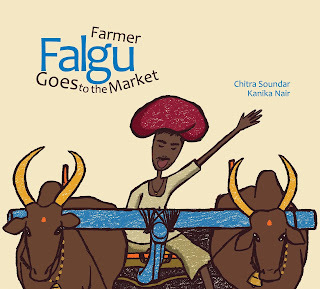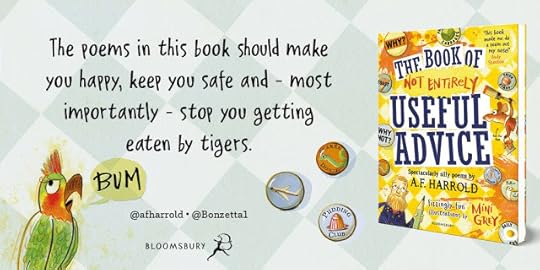Moira Butterfield's Blog, page 12
April 17, 2022
Eggstra-ordinary picture books about Eggs! by the Picture Book Denners
Lynne's egg book:
I nominate Tadpole's Promise written by Jeanne Willis and illustrated by Tony Ross
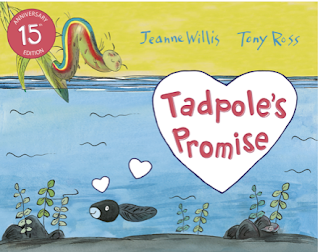 When eggs are mentioned, I think it’s fair to say most people think bird eggs. However, there are a huge number of other critters which lay eggs. For example, ladybirds, slugs and snails, earth worms, spiders, butterflies, and frogs. The book I’m nominating is about the last two on this list, a frog and a butterfly. Both of which hatch from eggs!
When eggs are mentioned, I think it’s fair to say most people think bird eggs. However, there are a huge number of other critters which lay eggs. For example, ladybirds, slugs and snails, earth worms, spiders, butterflies, and frogs. The book I’m nominating is about the last two on this list, a frog and a butterfly. Both of which hatch from eggs!I stumbled across this book in my local book shop. I was researching for a publisher, who might have been interested in a story I was working on. As I had limited time, I’d told myself I’d only flick through the books to get a feel for them and would, under no circumstances read them. Well… that didn’t happen.
I pulled Tadpole's Promise from the shelf and flicked to the first page. I began to read and just kept reading, until I’d reached the last page. It’s one of the few times I’ve had a laugh out loud moment in a bookshop, quickly followed by a little pang of guilt. I don’t want to give the ending away because it’s clever, it’s tragic and it’s amusing. Plus, it’s a great way to introduce children to the circle of life and the natural wonder of metamorphosis.
P.S. If you want to see the eggs for each species I’ve mentioned just click on the link.
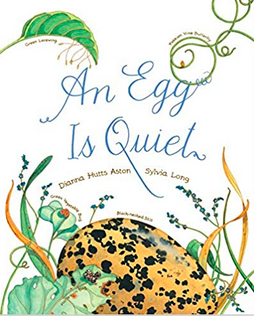 An Egg is Quiet by Dianna Hutts Aston and Sylvia Long
An Egg is Quiet by Dianna Hutts Aston and Sylvia LongNatascha's egg book:
AN EGG IS QUIET by Dianna Hutts Aston and Sylvia Long is part of a series of beautiful nature books. Each has deceptively simple, poetic main story text and layers of more detailed informational text about eggs belonging to all kinds of species.
The book opens with beautiful eggs on the front endsheets and the back endsheets feature lots of colourful hatched creatures.
It begins with a whisper . . .
"An egg is quiet . . ." (hatching), then builds:
An egg is also 'colorful' . . . (colours),
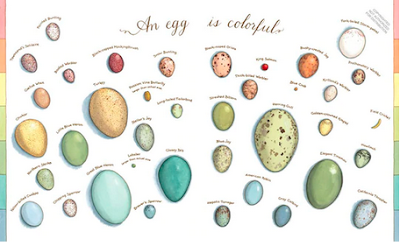 From An Egg Is Quiet by Dianna Aston & Sylvia Long
From An Egg Is Quiet by Dianna Aston & Sylvia Long'shapely' . . . (shapes), 'clever' (camouflage to safeguard from enemies) and 'comes in different sizes'. It is 'artistic', 'textured', 'fossilized', 'giving' (life cycle), and . . .
"Noisy!"
The book ends with the joyful sounds as the creatures hatch out into the world.
From tiny hummingbirds to giant ostrich, oval ladybird eggs to tubular dogfish eggs, gooey frog eggs to fossilized dinosaur eggs, the detailed images alongside the rhythmical text are mesmerizing!
Clare's egg book:
'All the birds had laid an egg. All except... Duck!'
That is until Duck finds the most beautiful egg in the whole wide world. The other animals aren't convinced initially. But a twist in the tale soon shows them the error of their ways.
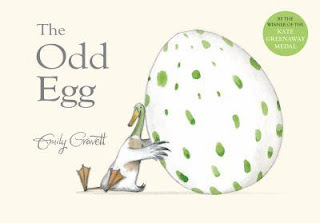
In the 'Odd Egg!' by Emily Gravett, the first thing that strikes me is how masterful the illustrations are. I love the softness of Emily's characters and the pencil line details. The book also has some clever novelty elements which add to the fun and interactivity and come into play with then eggs hatch. The double page where the reader meets the birds' babies is done so well!
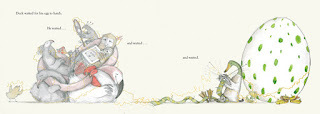
As well as warm illustrations, there's plenty of onomatopoeia spattered amongst in the concise text, drawing the reader in and making it a great read aloud. It might not be the ending you expect to this sweet, cutesy book... all the more reason I like it!
Jane's egg book:
I'm choosing "tell me a Dragon' by Jackie Morris (Frances Lincoln 2009)
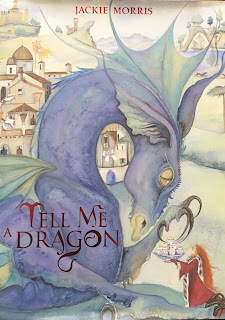
This may be a bit of a cheat, as eggs only appear in the endpapers!
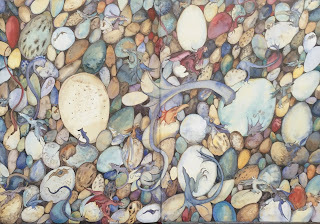
For years now, this beautiful, lyrical book has been the favourite of one or another of my four granddaughters. It's inspired us to have lots of fun together, collecting pebbles and dreaming up what type of dragon might hatch out of them.
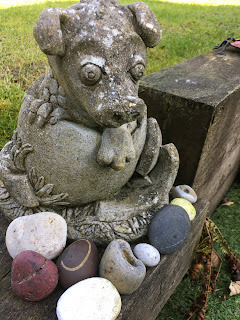 Jane's youngest garden dragon, guarding some pebbly 'eggs.'
Jane's youngest garden dragon, guarding some pebbly 'eggs.'Pippa's egg book:
Pip & Egg, written by Alex Latimer and illustrated by David Litchfield
Well, as a Pip, I had to choose that title, didn't I! But it's also a superb picture book, thoughtful and beautiful, kind and wise.
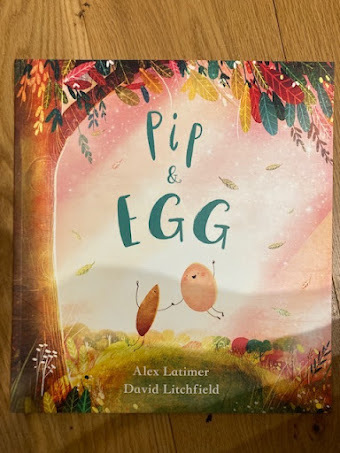
Egg and Pip become great friends, but then life brings changes. Unlike in wonderfully shocking Tadpole's Promise (see above), these two are destined to come through challenges to their friendship that leave them still good friends, but different, at the end. First Pip begins to sprout roots and can no longer move. Pip grows taller and leafier as we turn the pages. And then Egg changes ... into a baby bird! Pip understands when Egg needs to fly to a wonderful city to meet other birds. But guess where bird Egg wants to be when she realises she has an egg inside her? Back to the wonderful tree that Pip has become. What could be more satisfying?
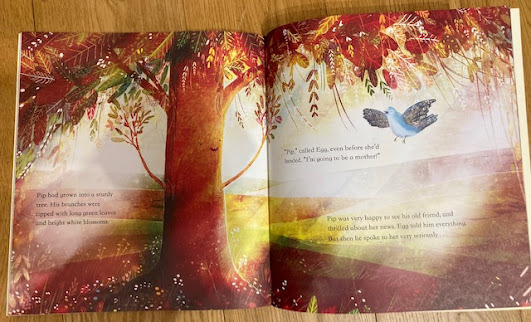
Chitra's egg book
In my egg book, the eggs are not characters. But they are both the victims and the heroes of the story. Farmer Falgu Goes to the Market is about eggs that have to crack to become something else. It's a story of making the best of any situation, and it's the story of resilience, even when it comes to something as fragile as an egg. I also wrote a detailed blog post about why I wrote about eggs when I don't eat eggs.
Moira's egg book
Well, here's a strange little tale about an egg picture book, and about being an author....Back in 2012 I was asked to write a book for ages 4-5 on eggs. Only it wasn't going to have any words! I was nonplussed but I said yes because the fee seemed generous for writing a book with no words, and there were royalties. I was asked to select photos from a picture library that would tell an unspoken narrative about eggs - a narrative using pictures that young emerging readers could chat about with a grown-up. So I found egg photos that told of animals such as fishes, crocodiles, seagulls and eagles....and so far 'What's In the Egg' has gone on to earn me 3 times the original advance. The lesson? As an author, don't necessarily say no to unusual opportunities, even if they sound a bit strange. Keep your mind open!
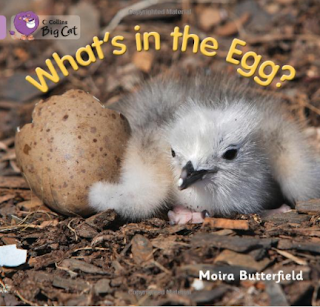 The book I 'wrote' with no words.
The book I 'wrote' with no words. Garry's egg book
J.Otto Seibold presents Other Goose. Re-nurseried!! and Re-rhymed!! Childrens Classics
If you're a fan of wacky and zany or you just want to shake things up a bit for Easter, then this is the book for you.
J.Otto Seibold re-tells some classic 'Mother Goose' nursery rhymes in his inimitable illustrative style. The book includes a chapter called ' Of Eggs and Accidents - fried, tried and justified' where Humpty Dumpty goes to the mall and buys some platform boots in the sale, size eggleven. In part two he steps in a hole and loses one boot which leaves him clopping around and around in circles.
Bonkers and lots of fun, this book gets my shout for Easter.
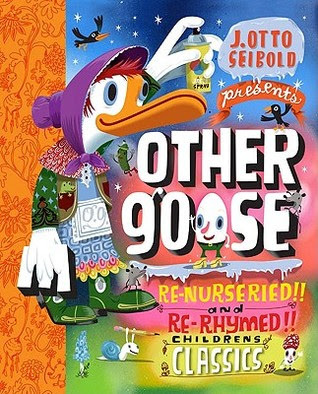
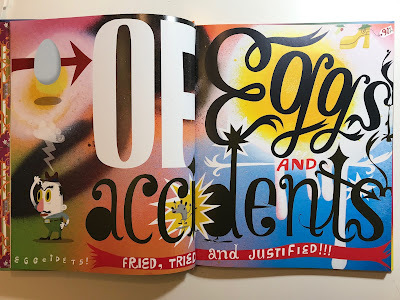

Mini's egg book
The Good Egg
I did a rather egg-based post back in February to mark 20 years since the publication of my very first book, which was about an egg (Egg Drop.) You can find it here. In it I do a round-up (OK, an oval-up...) of some favourite egg books including this one. Happy Easter, and wishing you the best of eggs!
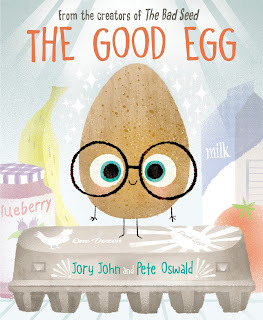
April 11, 2022
A Farewell to the Picture Book Greats: David McKee - by Garry Parsons
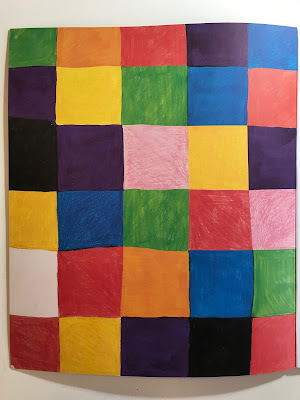
McKee's most famous story, Elmer, with his colourful iconic patchwork was first published in 1968 by Dobson Publishing and then re-released in 1989 by Andersen Press under the helm of Klaus Flugge and has since become a household name. McKee wrote and illustrated 29 Elmer books sparking a whole range of board books, toys and clothing. Flugge and McKee became firm friends. 'His was a singular voice and a shining light in children's books that highlighted inclusivity, diversity and parts of our world that are not always present in publishing for children.' McKee enjoyed drawing on letters to his friends and would often correspond with Flugge decorating the envelope as well. Flugge would pin these to the wall in his office at Andersen Press where other illustrators who were visiting would see them. Satoshi Kitamura, Tony Ross, Posy Simmons and Axel Scheffler, to name a few, began sending decorated letters and both Flugge and McKee's collections grew.



 Satoshi Kitamura has compiled a collection of decorated envelopes which includes many of McKee's drawings to Flugge in "Efuto" published by Foil. Envelopes decorated in this way are known as 'efuto' in Japan which translates simply as 'picture envelope'. Working with King Rollo Films, McKee co-created iconic animated programmes for the BBC including Mr Benn, about the eponymous explorer who through a magic costume shop went on a series of fantastical adventures.
Satoshi Kitamura has compiled a collection of decorated envelopes which includes many of McKee's drawings to Flugge in "Efuto" published by Foil. Envelopes decorated in this way are known as 'efuto' in Japan which translates simply as 'picture envelope'. Working with King Rollo Films, McKee co-created iconic animated programmes for the BBC including Mr Benn, about the eponymous explorer who through a magic costume shop went on a series of fantastical adventures.
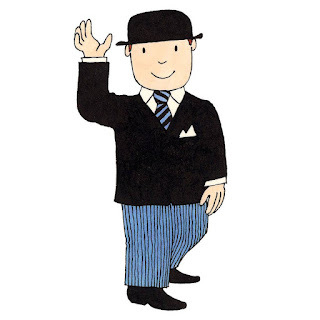 ' I wanted Mr Benn to be Mr Everybody. Bowler hats were more common in the early 1970s. There was a respectability to them, plus Charlie Chaplin and Laurel and Hardy are favourites of mine. Mr Benn went off on adventures according to whatever costume he tried on. I was heavily influenced by fables, because of their apparent simplicity. I like stories with a moral, that have a reason for being there – I don’t like a character to wake up and realise it was all a dream. That’s why I introduced the souvenir that Mr Benn always takes back with him, to say that it really did happen.'
' I wanted Mr Benn to be Mr Everybody. Bowler hats were more common in the early 1970s. There was a respectability to them, plus Charlie Chaplin and Laurel and Hardy are favourites of mine. Mr Benn went off on adventures according to whatever costume he tried on. I was heavily influenced by fables, because of their apparent simplicity. I like stories with a moral, that have a reason for being there – I don’t like a character to wake up and realise it was all a dream. That’s why I introduced the souvenir that Mr Benn always takes back with him, to say that it really did happen.'

Not Now Bernard was first published in 1980 and has never been out of print. Controversial on it's first publication and banned by some libraries for being violent, Not Now Bernard has become a classic. I remember being shocked and thrilled reading this for first time. The illustration showing the monster holding up all that is left of Bernard was a dark delight and a symbol I included in my own illustration of a boy who is swallowed by his 'Green Eyed Monster' in G.E.M by Jane Clarke. All that remains is a shoe!
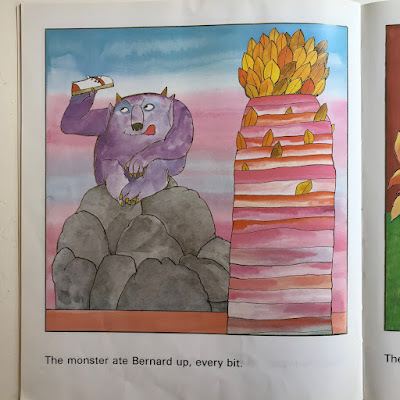
 But the picture book that epitomises David McKee's flair and brilliance for me is Two Can Toucan.
But the picture book that epitomises David McKee's flair and brilliance for me is Two Can Toucan.
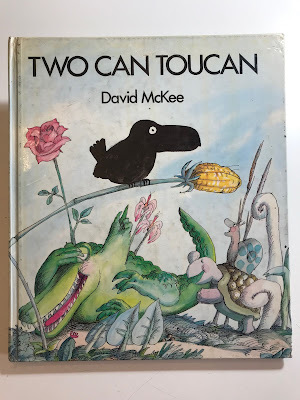
Two Can Toucan was McKee's first picture book published in 1964 by Flugge whilst he worked at Abelard-Schuman. It was then re-illustrated and re-published in 1985 by Andersen Press.
Back in it's original form it was republished again to celebrate the 40th anniversary of Andersen Press.
My copy is a little tired and worn but for good reason. Toucan's journey starts in the jungle with all the other creatures but heads to the town to seek his fortune.
McKee's wonderful illustration of the jungle is a page I return to often.


He finally he discovers he is good at carrying things, cans of paint in particular.
 I asked Picture Den members, Moira Butterfield and Pippa Goodhart for their insights and enjoyments of David McKee's work.
I asked Picture Den members, Moira Butterfield and Pippa Goodhart for their insights and enjoyments of David McKee's work.'I love the artwork and the child-friendly tone of David McKee. I recently worked on an Elmer book commentary for children with sight conditions, and that involved me looking very closely at the illustrations to describe their effect. The Elmer backgrounds are so rich and full of life. I’d say joyous. And his writing was absolutely pitched from a child’s point of view. No patronising. No trying to ram in some parental moral treatise. Just looking at life at the shoulder of a child.' Moira ButterfieldWhen I had just started as a young bookseller in Heffers Children’s Bookshop in 1982, David McKee was the first famous author/illustrator I met. He launched his ‘I Hate My Teddy Bear’ picture book in the shop, and of course I bought a copy and he signed it. Pippa GoodHart

'I worked with a friend in Heffers Children’s Bookshop who was lucky enough to get to keep all the originals of the shop's catalogue covers. Heffers were good at wining and dining people and asking for favours!
 The spirit of David McKee's work will, without doubt, live on to inspire and delight many more generations of children to come.
David McKee 1935 - 2022.
The spirit of David McKee's work will, without doubt, live on to inspire and delight many more generations of children to come.
David McKee 1935 - 2022.
***
Garry Parsons is an illustrator of children's books. His work can be seen hereFollow Garry on twitter and instagram @icandrawdinos
April 3, 2022
My picture book publicity movies By Moira Butterfield
A couple of years ago I started making mini publicity movies for my books. I post them on Youtube (I haven’t ventured onto Tiktok). I did post on Instagram TV but that doesn’t seem to exist now. Instagram now has a short reel thing going on, to try to go up against Tiktok presumably.
Nobody asked me to do this, but for various reasons I don’t spend time visiting schools so I decided it might be helpful to appear somewhere. Now I offer my mini movies to my publishers, who can use them for publicity if they so wish. That led to me making one specifically for a US publishing conference, and involving my illustrator. We tried to make it stand out and the publisher was very happy with the end product.
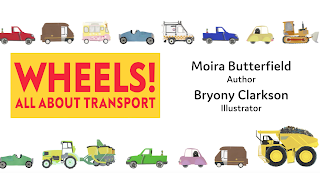 The opening of a movie for a US conference. We animated the vehicles and added sounds.
The opening of a movie for a US conference. We animated the vehicles and added sounds. Featuring illustrator Bryony Clarkson.
I find it a lot of fun to experiment with movies, though I think it’s fair to say my early efforts were somewhat haphazard and a wee bit crazy-looking. My various forays have certainly taught me a lesson about not trying too hard in front of the camera! But I learn a little each time I make one and I want to share some tips below in case you fancy trying movies, too.
I don’t generally get more than a few hundred views on Youtube but one of mine has racked up 67k views, so you never know. That one was boosted when the book got read out by a celeb, and is also used in schools in the US through Quarto Classroom.
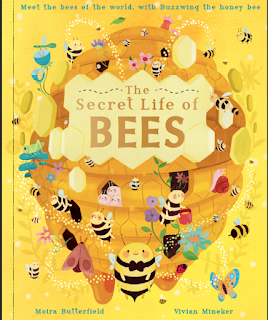 67k people have watched the videos for this Quarto book. The movie featured me and my next-door neighbour - beekeeper Phil. I haven't told him about the 67K yet. He might want paying or
67k people have watched the videos for this Quarto book. The movie featured me and my next-door neighbour - beekeeper Phil. I haven't told him about the 67K yet. He might want paying or he might just freak out!
I didn’t find setting up a Youtube channel hard. It was very clear. I put child settings on it and limited comments. I can take down my posts at any time. Nothing is permanent.
M’S MOVIE TIPS
* I script my movies and use an app called Teleprompter on my phone. It enables me to type in my script and then scroll it as slowly as I want. I mount my phone on a selfie stick which also has a small and somewhat rickety fold-out tripod on its base for standing on a table.
* I like to go out and about with my movies and that has taught me that the place where I live is unbelievably noisy! There seems to be daily drilling somewhere, plus revving trucks, car horns and sirens – and especially people calling their dogs in the park behind my garden. So it’s best to film somewhere quiet, and definitely not at school run time if you’re in town. Very early in the morning works well if I can get my act together.
* I film my movies in sections that get edited together. That way I can do takes and retakes and choose the best. Doing everything in one take is just too tough because I might garble words, sneeze, fall over or perhaps swear at the neighbour’s drilling!
*Being outside doesn’t require special lighting but I did find that the outdoor light reflects the colour of my clothes onto my face. This resulted in a very green face when I wore a green dress! It’s worth experimenting with clothes to minimise skin reflection.
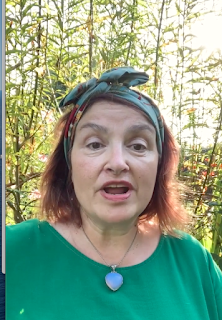 Green and ill-looking!
Green and ill-looking!
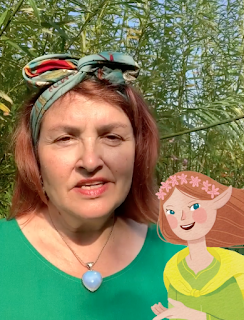 That's better.
That's better.
*I do have a desk halo light for filming inside but I haven’t actually used it yet. I brought a cheap green screen that I have used, however. It’s on a very rickety stand but it does the job (when it stays up) and enables some graphics to be put behind me when necessary. I used it for my movies on Dance Like a Flamingo and Sing Like a Whale (Welbeck), so we could add some of the illustrations.
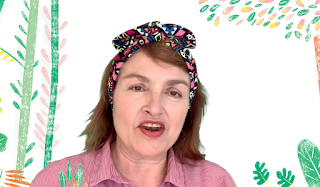 The green screen gets knocked out to add graphics
The green screen gets knocked out to add graphics
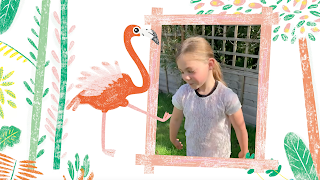 I like to get kids involved if I can. Luckily my relatives are game and give
I like to get kids involved if I can. Luckily my relatives are game and give permission to be shown.
* I don't mind looking a bit amateur. I am an amateur filmer! I do want the movies to have some character and so I'm happy that they aren't too slick, but I don't want them to be too ropey either. I pay a friend to edit my movies the way I want them – as I don’t have the skill. They add the graphics and music.
Publishers don’t pay me because I do this off my own bat. I know that novels, for example, get publisher-funded publicity reels but I’ve never been offered one. Perhaps one day I will, maybe even prompted by my amateur forays into the movies!
PS: After I wrote this blog I did some filming which came out pretty badly. No worries. I get to throw it away and do some more takes, but here are a couple of fails.
Er...I think those binoculars are the wrong way round, and did someone train the spotlight on your nose?
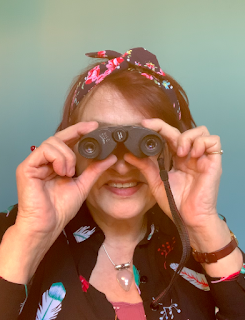
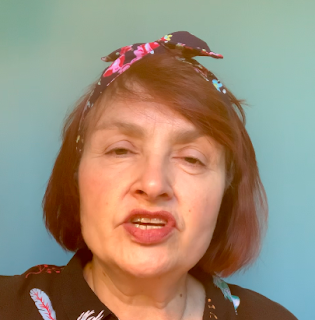
Moira Butterfield is known for writing non-fiction picture books. She is currently writing a follow-up to her bestselling Welcome To Our World (Nosy Crow). She has three books coming out in May – Maya’s Walk (OUP) aims to make daily repeated walks much more fun for pre-schoolers and their grown-ups. Grandma’s Story (Walker) aims to introduce children to the concept of history and get them chatting about childhood with the grown-ups they know. The Secret Life of Birds (Quarto) is part of the Secret Life series (following Trees and Bees). So she has a lot of filming to do!
Link to Moira’s movies:
https://www.youtube.com/channel/UCk74GKogEymUxb3HBNUNzhg?app=desktop
twitter @moiraworld
instagram @moirabutterfieldauthor
March 28, 2022
Ten ways to kickstart your writing if you’re stuck by Juliet Clare Bell
In case you're in need of a boost to your creativity at the moment (I have been!) here's a list of ten things you could try...
1 Be kind to yourself and seek out good company. If you’re anything like me you may still not be seeing as many people as you did pre-covid. We haven’t started back with our in-person once a month local SCBWI picture book group yet or our once a week writing together sessions we did for some time. I feel very lucky to have been able to go away for two weekends very recently with writer friends
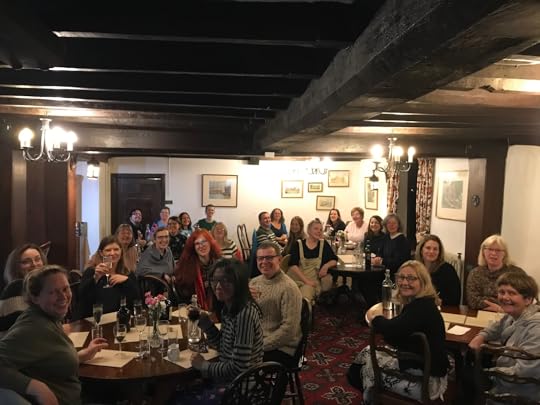
SCBWI Writing Retreat 2022 (masks off for eating)
I used to use retreats as a time to write but these weekends were a time to reflect and think, and most of all, be in really good company, talking about writing and being honest about how we’ve all been finding life and writing after the last two years… I am rejuvenated (and without meaning to, came up with a great idea for a picture book). f you’re not able to go away, try and connect in a different way -on a walk (in person with someone, or failing that, on a call to a friend elsewhere) or on zoom if you can still face it!
2 Be kind to yourself and read -either somewhere super nice and cosy

or in bed (with electric blanket underneath and weighted blanket on top -in my case) whether that’s with a physical book (for me, in my chair) or an audio book in bed…
And don’t feel like it can’t be as fun if you schedule it. I do fifteen minutes in my cosy chair after I’ve got completely ready for bed, with lovely lighting and bird song on spotify, and I frequently read at scheduled times with one of my teenagers in cosy silence. I will forget to do it if I don't have a reminder but it's lovely when I do it.
Try picture books and other books. They can all help you find your way back, even if they don’t seem connected to what you’re writing initially. I’m currently listening to Brene Brown’s The Gifts of Imperfection
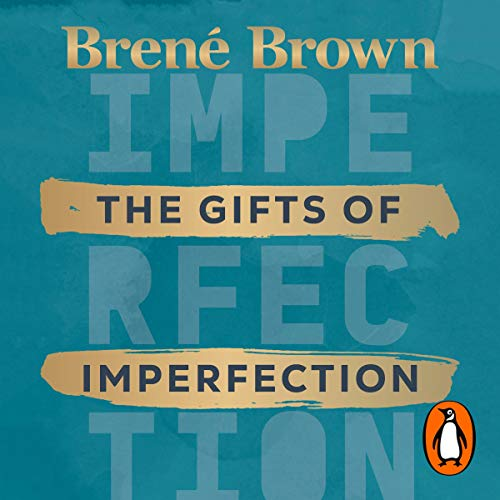
-I'd highly recommend it... I’ve also been listening to Elizabeth Gilbert’s Big Magic.
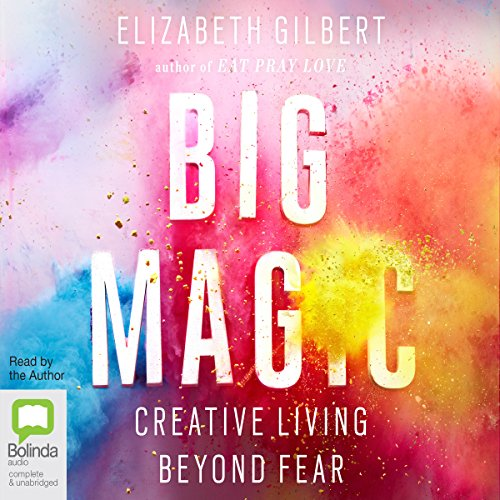
I don’t necessarily share her opinions about the universe deliberately putting positive things in your way but it doesn’t make any difference to how much I get out of the book and how it encourages me back into creativity.
3 Be kind to yourself and have a little book of small successes (for writing and writing-related successes) and write in it every day. My small successes are often very small (like sitting at my desk for fifteen minutes and doing a task I didn’t feel inclined to do but did anyway) and I am only allowed to write wholly positive things in there.
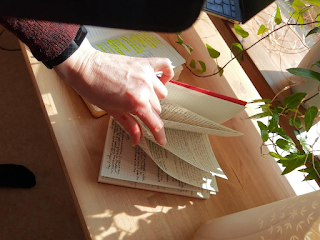
I do this at the end of the day, before bed, so I’m finishing on a high note and I do it at my desk with lovely calm lighting so it feels like a treat.

If I ever choose to read it, it is wholly positive, whether the success I’m reading is finishing a book or doing half an hour of taxes in one sitting…
4 Be kind to yourself and surround yourself with plants. I nicked this idea straight off my middle daughter and it’s been very lovely indeed.

5 Be kind to yourself and get a good working area if possible. Until I got my good working area which I absolutely love (in my bedroom) earlier this year when I bought my desk (and some months after I’d done a huge clear-out), my good working area was my bed. It wasn’t actually very good but I did make sure it was a happy area by covering it with a lovely yellow blanket.
6 Be kind to yourself and try and find ways to work less on computer and more on paper. I have to remind myself of this a lot as I’m wont to forget things quickly, but you can actually have your computer screen closed quite a lot of the time when you’re working on a picture book and it gives your working environment a very different (and often nicer) feel.
7 Be kind to yourself and look after your body -eat the right foods and exercise. For me (a perimenopausal woman with ADHD) that means religiously eating lots of flaxseed every breakfast without fail with yogurt, chia seeds, apple, toasted flaked almonds and a bit of honey, and it means cutting out almost all refined sugar. Two years ago I would never have dreamt of eating that and ate Coco Pops or cornflakes or another sugary cereal for breakfast, and lots of chocolate. But I borrowed the idea off other women of a similar age and it’s made a huge difference -as has HRT- helping my memory and reducing brain fog (very useful for writing!) And do whatever exercise works for you. For me, it’s jogging gently on the spot at home at regular times throughout the day and it does wonders for my concentration.
8 Be kind to yourself and embrace whatever works for you. It doesn’t matter if anyone else thinks it’s weird. You do you -whether that means dancing around the kitchen to seriously uncool music or jogging super-slowly in tiny steps up and down your not-so-large kitchen whilst you wait for the kettle to boil…

If you jog with tiny enough steps the kitchen seems pretty big (and it's great to get concentration back if you're losing it...
or putting on slippery socks so you can slide around on your floor, or playing tig at the park with your teenage children, or watching Brokenwoodwith a child whilst finishing a blogpost
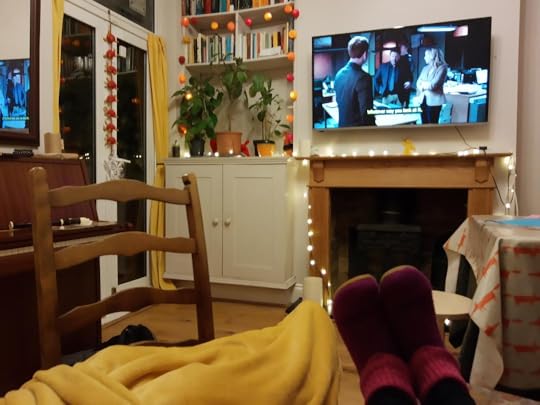
Seeking out good company at home, too, for writing, reading or just good old hanging out...
or learning to play the ukelele just for fun...

or using an actual sticker chart to motivate you to do all the helpful things that help things along…

It may seem childish, but I don't care. I nicked it off one of my children and it works for me!
9 And then be kind to yourself and think really carefully: is what you really want to be doing? If it is (and it’s fine if it isn’t) then plan your days (after years and years of trying different productivity journals and numerous variations on to do lists, I’ve finally found a way that works: a simple brightly coloured book (so I love using it and I can’t lose it -at least not as easily as less colourful books) with half the day’s page taken up with a random brain dump of absolutely everything I need to do and the other half a schedule based on the brain dump. And I get to use a highlighter once I’ve completed something...
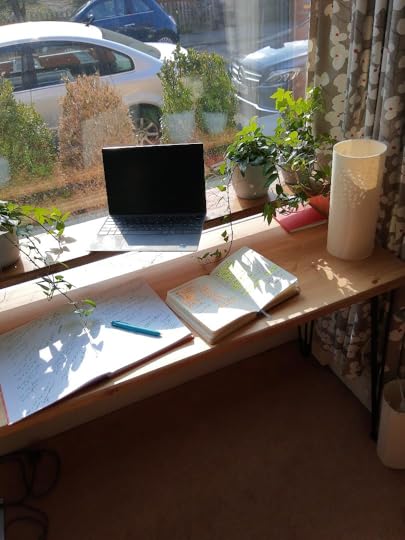
It's very yellow and I lose it way less than anything else -and who doesn't love a highlighter?
and then be kind to yourself and…
10 be authentic, take your inspiration and strength from everywhere and allow your re-invigorated mind to write what moves you.
These are things that have made a big difference to me recently and I'm getting more writing done and having more fun doing it! Let's all remember to be kind to ourselves (and of course, each other). What are your top tips for feeding your soul and being in a better place to write? I'd love to hear them in the comments below...
Clare is the author of around 40 books (picture books and early readers) and is editing her first young adult novel. She's recently questioned whether she wants to be moving on to older books now her children are much older but once she let herself imagine not writing more picture books she realised how much she actively wants to write picture books and it's really helped her focus.
March 20, 2022
CREATING STRONG PICTURE BOOK CHARACTERS
If I had to pin down some of my all-time favourite picture book characters, Burglar Bill (Janet and Allan Ahlberg) and the girl from Rebecca Patterson’s My Big Shouting Day would be up there.
I think what I’m drawn to is the darkness and danger in Burglar Bill. He's certainly interesting and someone I want to read more about. Plus, he has a fantastic refrain that I used to love joining in with as a child - ‘I’ll ‘av that!
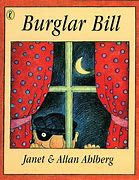
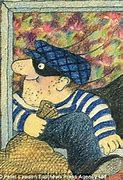
In My Big Shouting Day it’s the authenticity of the character that appeals to me. She's so well cast and familiar that I feel like I know her (Perhaps I do!) This spread in particular is fantastic and full of humour. Again I love the voice – ‘I CAN'T EAT THAT EGG!’
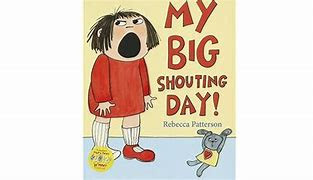
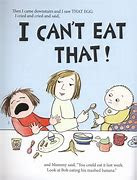
STRONG CHARACTERS
In more modern examples, I thought Yoyo from Emily Davison and Deborah Allwright’s Every Bunny is A Yoga Bunny was excellent – a fidgety, bouncy, can’t-sit-still-ever sort of bunny will be relatable to many young readers, making Yoyo's story easy to empathise with.
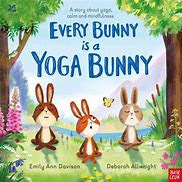
And it’s impossible not to fall in love with Gertie, the littlest yak! (Lu Fraser, Kate Hindley.) She may be small but she has a big dream. It's the contrast between her tiny physical size and her ambition that make us root for her even more. Also, the weather and dangerous setting heighten the stakes, increasing the tension and how much we care.
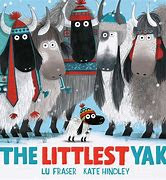
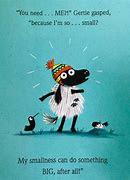
Whilst the advice is usually to make your characters relatable, Catherine Emmett breaks the mould showing us how to make the reader care about unlikeable characters in her cautionary tale, The Pet, with David Tazzyman. In this story about spoilt Digby David who doesn't look after or respect his animals, we keep reading to see if the main character is going to learn his lesson... or not. (Perhaps he is a bit relatable too! Shhh!)
LIke most of the books above, picture book creators are often advised to create child characters or characters that are child-like. But Catherine Emmett demonstrates that not all picture book main characters have to be children. In King of The Swamp, McDarkly is a grown-up monster character living alone in a swamp, but he has a clear plight that we can get behind and is very much likeable.
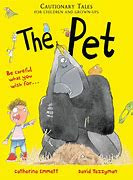
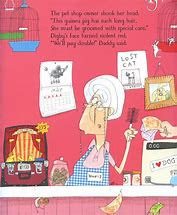
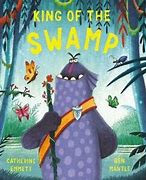
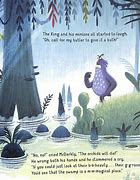
ARE YOU A CHARACTER-DRIVEN OR PLOT-DRIVEN WRITER?
Whilst it depends on the story and the idea, on balance I consider myself more of a plot-driven writer than a character-driven one. I get swept away by funny starters, escalatory ideas for middles, devastating crisis points, climatic endings, or by theme, and then I choose the character to star in my story afterwards.
For that reason, I have to work a little harder to create strong characters. Here are three tips I’ve gathered since I started writing which might help you with your characterisation too.
TIPS FOR DEVELOPING STRONG CHARACTERS
- 1. Quiz your characters:
I knew in Sunshine at Bedtime I wanted the main character to be a human child. In the story, Miki’s external goal was to learn about the Sun and all the ways its light works. To develop her internal traits, it helped to imagine Miki in my mind’s eye and to ask her what questions she had and to find out how the extra sunlight was affecting her everyday life. It quickly became apparent there was NO WAY Miki was going to go to bed when it was still sunny, which became the opening of the book. Interviewing your character might throw up some interesting ideas to explore.
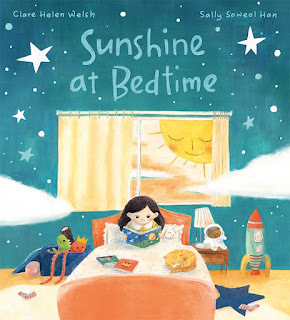
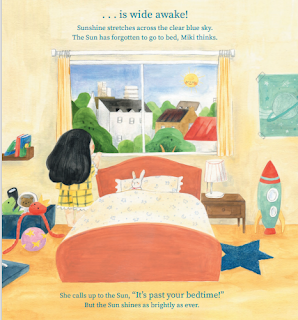
- 2. Base them on someone you know or a celebrity :
In the Dot and Duck series, I’ve very much taken inspiration from my life. How Rude came from imagining my children at their worst. How Selfish was inspired by my time in Early Years environments. The third adventure, How Messy, was more specifically inspired by my marriage! Not that one or other of us is Dot or Duck – we have our moments as both characters – but it helped to imagine incidents and real life examples and to plough those details and emotions into the story. Can you base your character on someone you know, or know of? Even if just in part? It makes them easier to visualise and makes it easier to predict how they will react in certain situations.
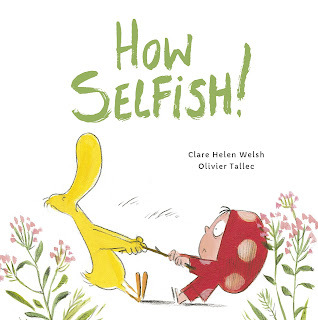
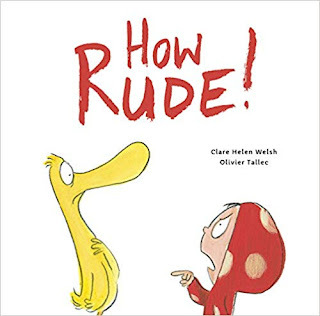
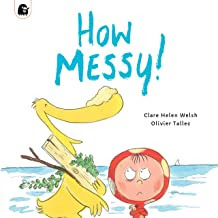
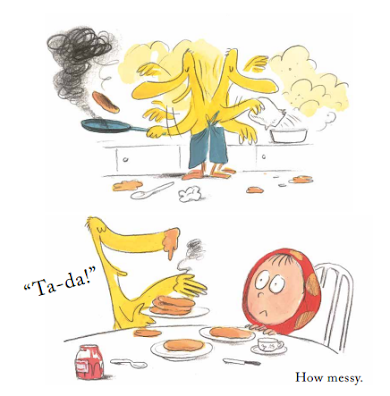
- 3. Take the theme of your texts and cast the character/s that will cause the most conflict
In the Lenny series, I chose the characters that would provide the most 'story'. Who were the smelliest, yuckiest, slimiest animals on the planet?! These were the creatures I knew Lenny needed to meet. The smellier, yuckier and slimier the animals, the higher the stakes for the character and the more potential there was for conflict and humour. Have you got the worst combination of character and conflict in your story? An uncoordinated giraffe that wants to dance? An owl who is afraid of the dark?
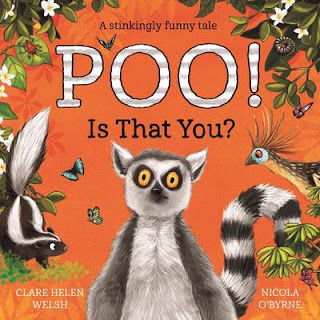
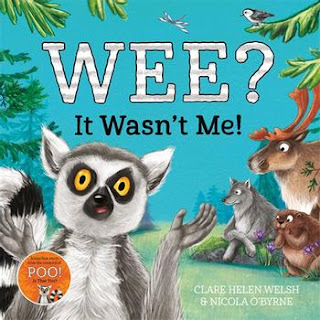
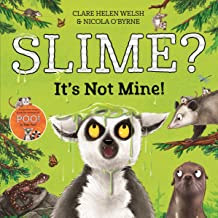
DO CHARACTERS ALWAYS NEED TO BE DISTINCTIVE?
I think it’s also worth considering that sometimes it’s ok if your character is justa child. If your text deals with a big theme or has a hard hitting conflict, you might not need such an outwardly unique character. For example, in The Tide (Ashling Lindsay) and The Perfect Shelter (Asa Gilland), the main characters are just children – one who loves the beach and one who loves building dens. Written in first person they are intentionally quite generic, which I think works. There’s enough conflict going on in the world around them. One girl is learning to accept her grandparent's dementia and the other her sister's critical illness. The plot points and emotional themes are the hooks for the story, not the uniqueness of the character.
Remember though, that even if you decide your human characters don’t need to be that distinctive, they still need to be clear. You could try cementing their personality in the early pages, with a line or two that tells us exactly all we need to know.
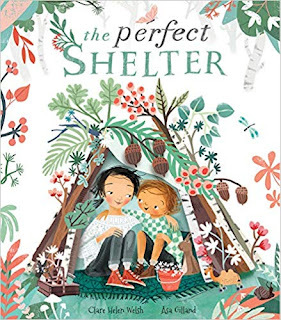
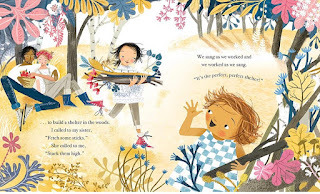
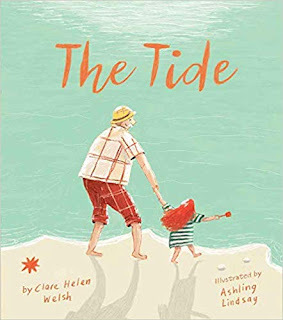
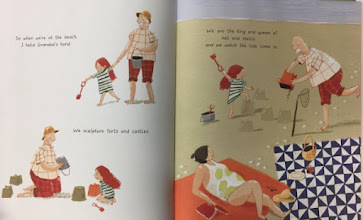
The good news is that where picture books are concerned, it’s not all about the words! Illustrations bring characters alive in a physical sense, of course, which for me is like meeting them for the first time! I don't ever imagine my characters in that much detail. But they also add to the characterisation in untold, magical ways. Like when Laura Barrett illustrated Scissorella and hid animals mentioned in the original fairy tale like lizards, mice and a cat adding to Lotte’s kind and caring persona. So if your characters feel a little flat, that might not be a bad thing - it could leave space for the perfect illustrator to breathe life into them and bring them into their own.
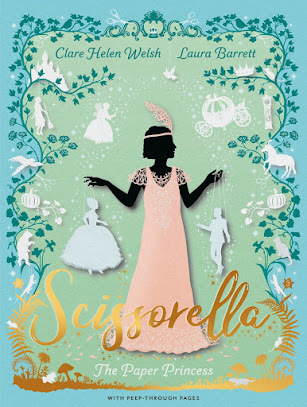
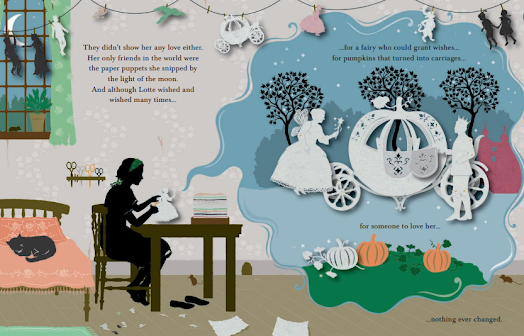
WHAT ABOUT YOU?
I wonder if you have any top tips for creating clear, interesting, relatable, authentic, distinctive, like-able characters that we care about. Would you consider yourself a character-led writer or plot-led writer or both?!
Feel free to let us know in the comments below.
BIO: Clare is a children's writer from Devon. She writes fiction and non-fiction picture book texts - sometimes funny, sometimes lyrical and everything in between. Her first book was published in 2015, and she currently has books in development with Little Tiger Press, Quarto, Nosy Crow and MacMillan. Her next narrative non-fiction picture book, 'Sunshine at Bedtime,' comes out in just a few weeks with Storyhouse Publishing and has been illustrated by Sally Soweol Han. It's a magical but educational adventure explaining why the sun sets later in the summer. You can find out more about Clare at her website www.clarehelenwelsh.com or on Twitter @ClareHelenWelsh.
March 14, 2022
War and Peace in Picture Books by Chitra Soundar
While I begin writing this, the war of terror by a nuclear power over its neighbour looms large in my mind. Like me, many of us I’m sure are either ignoring the news or obsessively consuming it. (If you want to help, here are some ways.)
But are children aware of the war? Are they talking about it? Are the grown-ups having a meaningful conversation with them about it?
I was in a school recently, talking about climate crisis (related to my books) and the students offered up war as one of the things destroying the planet. It’s on their minds. They are hearing the news. They are listening to the grown-ups discuss the topics. They might even be refugees of a previous war afraid of this new one.
That made me wondering, how do we talk about war (and peace) to children? How do we explain why one big bully attacks another? How do we explain displacement, refugees and bombs to the youngest of our readers?
Perhaps we already do. Perhaps we don't continue to do it when they grow up.
From the time children go to nursery to socialise with other children, we teach them to take turns, to say please and thank you, to help each other, respecting a No, not grabbing and to share.
How are these different to international rules of playing together nicely in the nuclear sand-pit? We often forget that these rules had never changed from the nursery to the United Nations.

• We take turns to be leaders at the United Nations.
• We help each other albeit in randomly unfair ways.
• We must accept and move on when someone says No, to re-joining an empire
• We must not at any time grab what’s not ours
• We must share our goodies, our vaccines, our expertise with other nations.
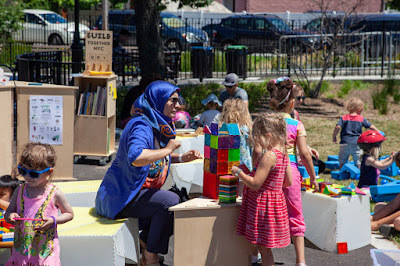
The nursery is not perfect. There are tantrums, fights, throw-downs and toy-grabs. The children are still learning these skills for the first time and their brains are still developing. But if we do not show them how to play nice with others at this age, if we do not build in the values of respecting every life equally now, we will be in a cycle of war that will destroy the planet in drastic ways.
To be honest, United Nations is not perfect either. Neither is the world order. Perfection is a dream. We have an imperfect world and world order and however imperfect, we hope peace and humanity wins over greed and ego.
In my opinion, picture-books for younger and older children, have the power to start conversations about such difficult topics. Books can help showcase the people who are displaced, the children who are traumatised and the everyday life that is affected when someone far away decides to act on their greed and ego. They also remind us of the good that exists amidst the chaos.
• The courage and bravery of those who defend their right against the war.
• The kindness of strangers and neighbours.
• The lessons we learn and pass on to the next generation.
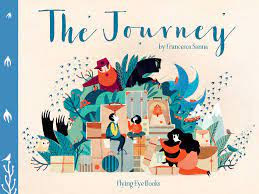
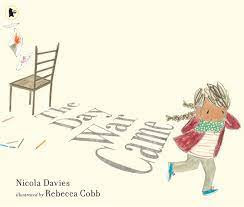
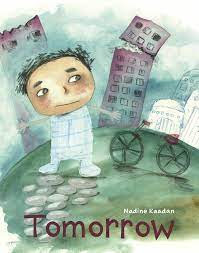
Conversely, picture books about sharing, about not biting your friend because they won’t give up their toy or taking turns at the slide without pushing each other out of the way are also important. These stories are the foundations on which our values are built.
The picture book listener has a fertile mind. They laugh at weird sounds, they love repetition, they love snuggly animals. But they are also taking in the underlying thread without the grown-up reader having to elaborate much. If not, the next day at the nursery or school, eventually the child can correlate to the story to what they are saying.
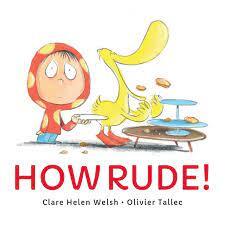
Often they see it in others first. “Tommy didn’t share today.”
“It was my turn but Lucy pushed me down.”
“I didn’t want to give my train but Arun grabbed it anyway.”
Then they will see it in themselves. Then it turns into empathy. It turns into a life-long value they will hopefully retain and turn into generous and kind citizens and leaders.
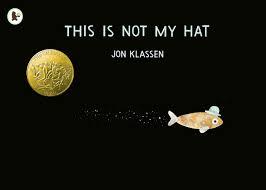
So, there is a place for both types of stories – the ones that talk about the fundamentals of how we aspire to be and the ones that talk about the immediate plight of the people affected by war.
Which one will you write?
Here are more books Love My Books have put together that talks about the perils of war.
http://www.lovemybooks.co.uk/top10-children-in-conflict
Here are some books that talk about sharing. There are plenty more about not being rude, taking turns and being kind.
https://anitacleare.co.uk/books-to-teach-children-social-skills/
Can you recommend other books that directly or indirectly talk about peace or the futility or the cost of war or simply those universal values of love, sharing and being kind? Share with us in the comments.
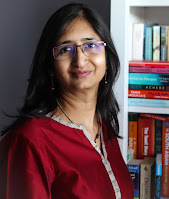
Chitra Soundar is an internationally published, award-winning author and storyteller, who is inspired by mythology, culture and folktales from across the world. She believes every story needs to be celebrated and there is a story behind every celebration.
Her latest picture books are Holi Hai! And We All Celebrate. Find out more at http://www.chitrasoundar.com/ and follow her on twitter here and Instagram here.
February 27, 2022
The Beauty of Slowing Down, by Pippa Goodhart
Do you remember the wonder and beauty of that first lockdown in spring of 2020?
There were those who were doing the caring, facing the worst horrors of covid in overstretched hospitals, risking their lives to keep transports and food supplies moving, working all hours to teach our children in person and online, and many more doing ‘key’ jobs. Two of my daughters were caring for covid patients, one barely protected by paper mask, plastic apron, and goggles donated by a local school, the other better equipped but pregnant and not knowing what the potential harm to her child might be from the patients with covid she was treating. All of it pre-vaccinations of course.
But for my husband and me, and millions more lucky ones, there was another side to this time when so many ‘normal’ activities became impossible. The sky, seemingly clear of aeroplanes, was bright blue day after day. The colours of spring flowers opening seemed more vivid than ever before, the bird song richer. I remember standing on a footbridge over the M11 motorway, and seeing empty road on either side as far the eye could see. One bright May morning we took our inflatable canoe on Cambridge’s Backs, normally a time and place where the river would be crammed with tourists being punted up and down. We took our allotted hour’s exercise in paddling down river and back, and saw not a single other human river user. But the blue sky was being scribbled on by a small ‘plane enjoying itself as it practiced to offer sky hearts to the NHS. What privilege of calm and beauty and humour and kindness for some of us, even whilst others worked harder than ever before.
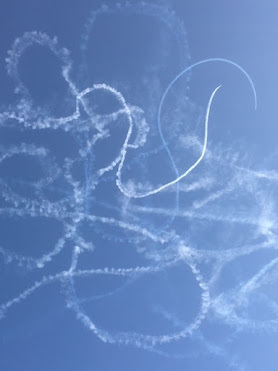

So, when publisher Tiny Owl asked me to write a picture book that captured something of what we had learned from our lockdown experiences, it was the slowing down and noticing things that felt to me to be the appropriate focus. Children reading the resulting book would either not remember those lockdown times, or simply not know how unusual they were. We adults have the context of ‘life before’ all that, but young children have only the context of ‘life after’ … so far as it has settled to a new kind of normal. Certainly there’s now again a feeling of rush, with a perceived need to catch up with everything, including what children might have been missing out on. The calm has gone.
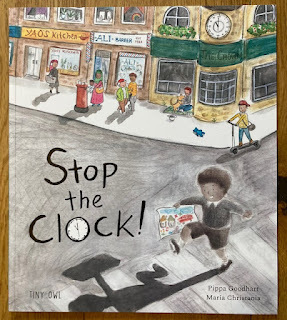
The story I wrote, ‘Stop The Clock!’, richly and cleverly illustrated by Maria Christania, makes no reference to the Covid 19 pandemic. Indeed, the illustrations developed from ones in which some people in the street were wearing face masks to none doing that. But it isn’t a story that shies away from more ongoing social issues.
Joe is rushed to school by Mum, and then rushed in his work in school by teacher Mr Khan, both of those adults nagged by clocks ticking onwards. But Joe wants time to think and to finish the picture he’s painting. So – and here’s the beauty of what stories can do which real life can’t – he stops time. He goes back over the route taken to school, now noticing the colour and interest and detail, adding those things to his picture. He finds the reason why little sister Poppy was crying, but there’s so much more to see. The bird plopping poo onto somebody’s head! The beggar in the doorway. The exhaust from the bus making the cyclist cough. The Venus fly trap plant about to snap shut on a fly. The cake squelching as a bite is taken. And much more.
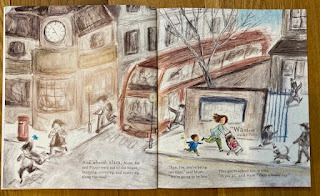
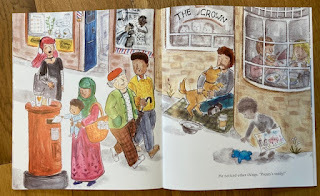
My favourite pictures in the book are Joe’s painting. The difference between the opening and closing endpapers summarise the story beautifully –
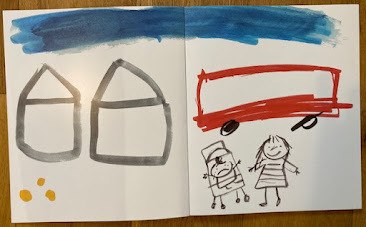
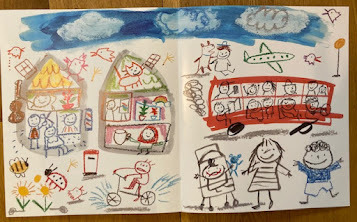
Tiny Owl commissioned pieces for another, very different, book about what we experienced and learned from lockdown times. They asked their illustrators to produce images and writing about how the experience had been for them. The result is 'Unlocked', a moving, funny, and inspiring. It genuinely brings a tear or two to my eyes, and also makes me laugh. These wonderfully creative people from around the world (Switzerland, the UK, the Netherlands, Iran, South Africa, Portugal, Italy) all found imaginative ways of making the most of the necessary restrictions. Music, gardening, zoom parties, cooking, and just closing eyes and properly listening are just some of the things they did. This book is one for everyone, and I’ve bought it as a gift for more than one adult now. Highly recommended.
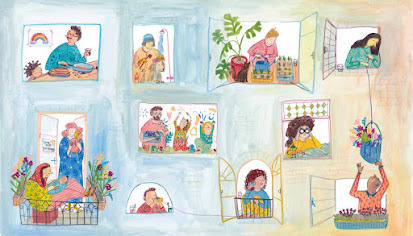
There have been children’s books explaining covid and vaccinations, and books praising our rescue services in pandemic times. But do please make comments below suggesting other books which aimed to capture that ‘time out’ experience of months of restrictions.
February 20, 2022
No use crying over smashed eggs…Egg Drop 20 years on - Mini Grey

Time flies, and eggs don’t. It’s 20 years since my very first picture book, Egg Drop, crashed into the world.
So in this post I’m going to have a look at what I did and didn’t know then, and what I do (and still don’t) know now. Through a twenty-year telescope.
20 years ago….
I’d been working as a primary school teacher, but had harboured an ambition for a long time to make a picture book, only made stronger by all the picture books I loved reading with the children in my class. So I’d done an MA in Sequential Illustration at Brighton (supply-teaching part time to make ends meet). And then, amazingly luckily, I met an editor, Ian Craig, at Jonathan Cape, who sportingly decided to publish a story I’d made called Egg Drop.
20 years ago….
I didn’t even know how many pages a picture book has, or how they ‘work’.
Ian explained it: you have usually 32 pages to work with. In a hardback EITHER pages 01 and 32 will be stuck down into the cover OR you can also have extra endpapers, which give you pages 01 and 32 to use for your story too (well, probably title page and copyright.) Endpapers tend to be in a colour you choose from the pantone book, and you can make this into a design in that colour if you wish. If you want full-colour endpapers, they’ll need to be part of your 32 printed pages, so that means going with pages 01 and 32 stuck down (inside the cover), and endpapers on pages 02&03, and 30&31, which is what we did with Egg Drop. Of course, that means you’ve used up 4 pages on endpapers you could have used for your story. Plus you've stuck down pages 01 and 32, so 6 pages gone already. But if your story is pretty minimal, maybe that’s a good thing….
With Egg Drop, I happened to have a story that was SO MINIMAL we actually had to expand it to get it to fill up the book. (This has never ever happened again since.)
 The first version of Egg Drop, made to sell at the London Artists' Book Fair
The first version of Egg Drop, made to sell at the London Artists' Book FairIan my editor taught me: to be kind to my reader, to start in a place of familiarity, especially if you’re planning to guide them somewhere really weird.
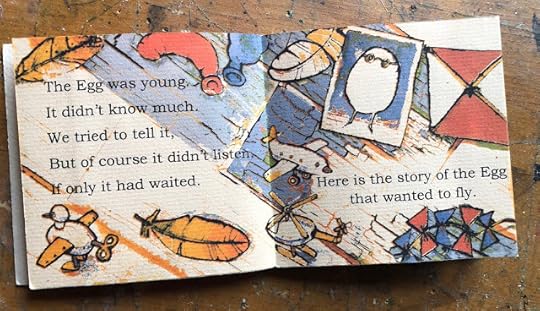 This version of Egg Drop started off, a bit confusingly, in an attic.
This version of Egg Drop started off, a bit confusingly, in an attic.So rather than starting my story in a strange attic space full of the Egg’s mementoes, Ian said – start on the farm, start with your chicken who is telling the story, so your reader feels on familiar territory, and then they’ll trust you to lead them into a world where eggs jump off towers.

 20 years ago….
20 years ago…. The bravery of ignorance is a wonderful thing.
Like the Egg, I didn’t know much, and I wasn’t comparing my book to all the other picture books out there, so I blissfully threw things together without worrying too much about it.
I made the artwork on paper and it all got sent off to be scanned. I had no idea what the scanner was like, I imagined something like combination of a fusion reactor and an MRI machine.
Nowadays I tend to make layers for my pictures and put these together in photoshop like a sort of a collage, which gets sent as digital artwork to my publishers. I very rarely make an image as one complete piece. This is good but also sad. The good is: you can keep moving things around and swapping them about and I often have several goes at characters for pictures and choose the one I like best. The sad is: you tend not to end up with an image that can be exhibited (or sold!!).
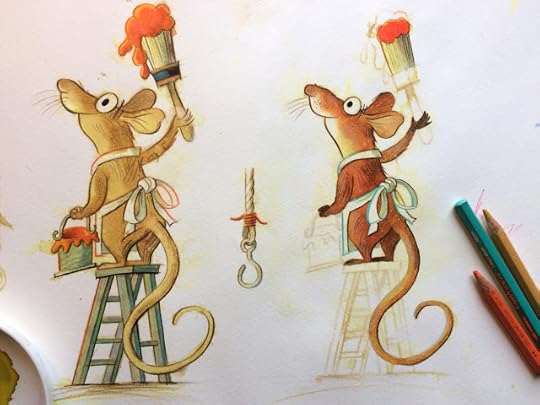 Making multiple mice for The Book of Not Entirely Useful Advice
Making multiple mice for The Book of Not Entirely Useful AdviceOne page from Egg Drop caused all the trouble.
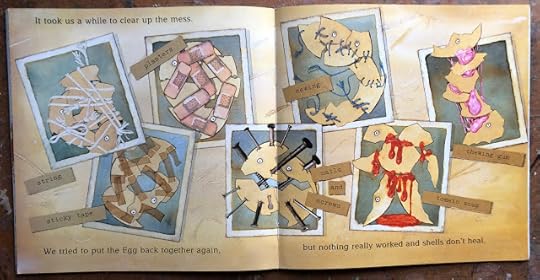
The ‘Putting the egg back together again’ picture featured string, sewing, tomato soup, bubblegum. It was a bit too chunky going through the Drum Scanner Machine and there were too many shadows on the scan. Someone cleaned them off digitally I think – but a little too thoroughly in places.
20 years ago….
I didn’t think designing the cover was my job. Or designing the cover typography. I didn’t realise how important a cover is, that it’s the first chance your book has to introduce itself.
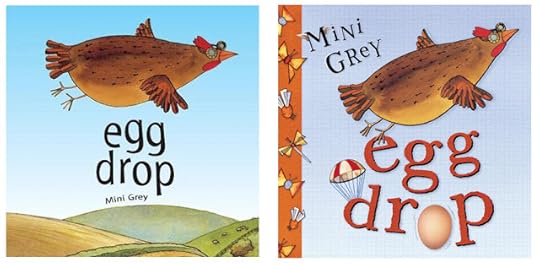 Egg Drop covers: hardback on the left, paperback on the right.
Egg Drop covers: hardback on the left, paperback on the right.Ian suggested having a flying chicken on the cover, so I made a chicken and some landscape, but I left it to the designer to put it all together and choose a font for the title. For the paperback, we changed the cover to something that felt a bit more in tune with the artwork inside, and was also more collagy.

I was discovering the fun you can have with snippets of newspaper reports.
For the paperback we used more of this for blurb and quotes on the back.
20 years ago….
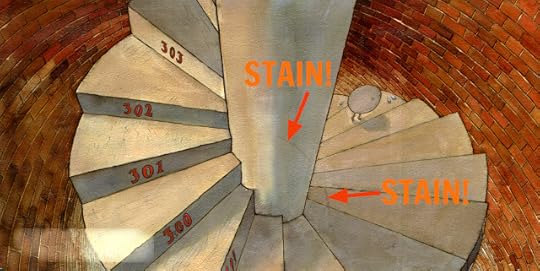
I was happy with very slapdash pictorial practices. Like coffee cup stains on my artwork (that a designer kindly suggested cleaning up digitally.). And really badly painted endpapers – I’d NEVER do them like that now, and I’d at least use masking fluid.
 Egg Drop endpapers front and back. I painted round all the eggs. Nowadays I'd make it so I could paint the sky in one big wash, so the eggs are floating in space. Or make it in a flatter, more graphic way, that nods to printed endpapers from the past (Endpaper Fans: have you seen Garry's post about endpapers?)
Egg Drop endpapers front and back. I painted round all the eggs. Nowadays I'd make it so I could paint the sky in one big wash, so the eggs are floating in space. Or make it in a flatter, more graphic way, that nods to printed endpapers from the past (Endpaper Fans: have you seen Garry's post about endpapers?)I also had a habit of putting a layer of acrylic varnish on my paintings. I liked them looking all saturated and shiny, also once varnished you couldn’t do anything more to them. I’d never do that now – it muddies up the watercolour textures, and shiny things are tricky to scan.
I made this book on the dining table in a 2 bedroom flat in north Oxford, living with my partner Tony and also Chris who rented the other bedroom and never complained about my mess. (And also our cats Bonzo and Bonzetta).
I also managed to fit in watching lots of daytime TV shows and long walks across Port Meadow. And I was doing part-time primary school teaching.

20 years ago…
A paperback Egg Drop cost I think £5.99.
Nowadays, the equivalent paperback costs about£6.99.
In 20 years children’s book prices haven’t changed very much at all (but what about paper & production costs?)
If we look at a shopping basket of supermarket food - the cost of that food is actually cheaper nowadays in real terms than it was 20 years ago.
The average UK salary in 2002 was about £20K. In 2020 it was a little over £30K.
But if we have a look at house prices, UK house prices have doubled and sometimes trebled in the last 20 years.
20 years ago…
I didn’t really realise how lucky I was to meet probably the only editor who would decide to publish this bonkers book, with its disastrous ending.

I think sometimes some of what our books are about is hidden from us. My partner Tony’s very best friend Dave killed himself in summer 2000. I wonder now if the tragedy of the egg throwing itself to its doom, and Dave’s tragedy, are linked.
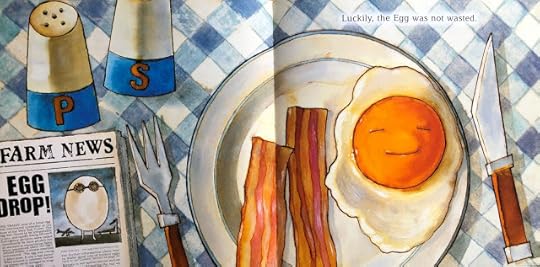
So I offer a final salute to courageous publishing. To editors who take a tremendous risk and decide to publish something strange, dark or unusual. One of the reviews of Egg Drop that most stayed with me was a quote from Lyn Gardner in The Guardian:
“By the end of the book you have a warm feeling towards a publishing industry that allows a book such as this to appear.”
Do you like books about eggs? Here are a half dozen more egg books.
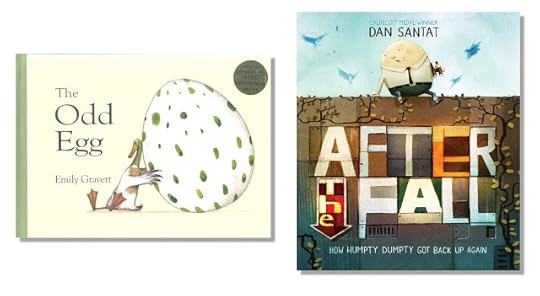 Duck struggles with a mysterious egg and Humpty struggles with eggsistence in The Odd Egg by Emily Gravett and After the Fall by Dan Santat
Duck struggles with a mysterious egg and Humpty struggles with eggsistence in The Odd Egg by Emily Gravett and After the Fall by Dan Santat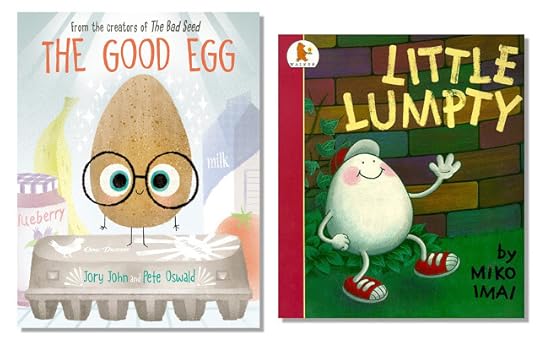 Two good eggs eggsperiencing difficulties: The Good Egg by Jory John and Pete Oswald, and Little Lumpty by Miko Imai
Two good eggs eggsperiencing difficulties: The Good Egg by Jory John and Pete Oswald, and Little Lumpty by Miko Imai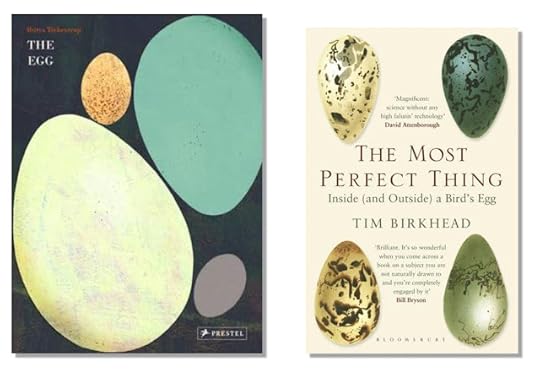 More factual-style eggs from Britta Teckentrupp and Tim Birkhead. (The last is not strictly a children's book but, well...what a miracle an egg is.)
More factual-style eggs from Britta Teckentrupp and Tim Birkhead. (The last is not strictly a children's book but, well...what a miracle an egg is.)Have you got a favourite egg book I’ve missed? – please let me know about it here or on Twitter.
Coming at the end of April 2022: The Greatest Show on Earth!

Mini's latest published book-involvement is The Book of Not Entirely Useful Advice, with AF Harrold. Her BlogSite is at Sketching Weakly.
No use crying over smashed eggs…Egg Drop 20 years on

Time flies, and eggs don’t. It’s 20 years since my very first picture book, Egg Drop, crashed into the world.
So in this post I’m going to have a look at what I did and didn’t know then, and what I do (and still don’t) know now. Through a twenty-year telescope.
20 years ago….
I’d been working as a primary school teacher, but had harboured an ambition for a long time to make a picture book, only made stronger by all the picture books I loved reading with the children in my class. So I’d done an MA in Sequential Illustration at Brighton (supply-teaching part time to make ends meet). And then, amazingly luckily, I met an editor, Ian Craig, at Jonathan Cape, who sportingly decided to publish a story I’d made called Egg Drop.
20 years ago….
I didn’t even know how many pages a picture book has, or how they ‘work’.
Ian explained it: you have usually 32 pages to work with. In a hardback EITHER pages 01 and 32 will be stuck down into the cover OR you can also have extra endpapers, which give you pages 01 and 32 to use for your story too (well, probably title page and copyright.) Endpapers tend to be in a colour you choose from the pantone book, and you can make this into a design in that colour if you wish. If you want full-colour endpapers, they’ll need to be part of your 32 printed pages, so that means going with pages 01 and 32 stuck down (inside the cover), and endpapers on pages 02&03, and 30&31, which is what we did with Egg Drop. Of course, that means you’ve used up 4 pages on endpapers you could have used for your story. Plus you've stuck down pages 01 and 32, so 6 pages gone already. But if your story is pretty minimal, maybe that’s a good thing….
With Egg Drop, I happened to have a story that was SO MINIMAL we actually had to expand it to get it to fill up the book. (This has never ever happened again since.)
 The first version of Egg Drop, made to sell at the London Artists' Book Fair
The first version of Egg Drop, made to sell at the London Artists' Book FairIan my editor taught me: to be kind to my reader, to start in a place of familiarity, especially if you’re planning to guide them somewhere really weird.
 This version of Egg Drop started off, a bit confusingly, in an attic.
This version of Egg Drop started off, a bit confusingly, in an attic.So rather than starting my story in a strange attic space full of the Egg’s mementoes, Ian said – start on the farm, start with your chicken who is telling the story, so your reader feels on familiar territory, and then they’ll trust you to lead them into a world where eggs jump off towers.

 20 years ago….
20 years ago…. The bravery of ignorance is a wonderful thing.
Like the Egg, I didn’t know much, and I wasn’t comparing my book to all the other picture books out there, so I blissfully threw things together without worrying too much about it.
I made the artwork on paper and it all got sent off to be scanned. I had no idea what the scanner was like, I imagined something like combination of a fusion reactor and an MRI machine.
Nowadays I tend to make layers for my pictures and put these together in photoshop like a sort of a collage, which gets sent as digital artwork to my publishers. I very rarely make an image as one complete piece. This is good but also sad. The good is: you can keep moving things around and swapping them about and I often have several goes at characters for pictures and choose the one I like best. The sad is: you tend not to end up with an image that can be exhibited (or sold!!).
 Making multiple mice for The Book of Not Entirely Useful Advice
Making multiple mice for The Book of Not Entirely Useful AdviceOne page from Egg Drop caused all the trouble.

The ‘Putting the egg back together again’ picture featured string, sewing, tomato soup, bubblegum. It was a bit too chunky going through the Drum Scanner Machine and there were too many shadows on the scan. Someone cleaned them off digitally I think – but a little too thoroughly in places.
20 years ago….
I didn’t think designing the cover was my job. Or designing the cover typography. I didn’t realise how important a cover is, that it’s the first chance your book has to introduce itself.
 Egg Drop covers: hardback on the left, paperback on the right.
Egg Drop covers: hardback on the left, paperback on the right.Ian suggested having a flying chicken on the cover, so I made a chicken and some landscape, but I left it to the designer to put it all together and choose a font for the title. For the paperback, we changed the cover to something that felt a bit more in tune with the artwork inside, and was also more collagy.

I was discovering the fun you can have with snippets of newspaper reports.
For the paperback we used more of this for blurb and quotes on the back.
20 years ago….

I was happy with very slapdash pictorial practices. Like coffee cup stains on my artwork (that a designer kindly suggested cleaning up digitally.). And really badly painted endpapers – I’d NEVER do them like that now, and I’d at least use masking fluid.
 Egg Drop endpapers front and back. I painted round all the eggs. Nowadays I'd make it so I could paint the sky in one big wash, so the eggs are floating in space. Or make it in a flatter, more graphic way, that nods to printed endpapers from the past (Endpaper Fans: have you seen Garry's post about endpapers?)
Egg Drop endpapers front and back. I painted round all the eggs. Nowadays I'd make it so I could paint the sky in one big wash, so the eggs are floating in space. Or make it in a flatter, more graphic way, that nods to printed endpapers from the past (Endpaper Fans: have you seen Garry's post about endpapers?)I also had a habit of putting a layer of acrylic varnish on my paintings. I liked them looking all saturated and shiny, also once varnished you couldn’t do anything more to them. I’d never do that now – it muddies up the watercolour textures, and shiny things are tricky to scan.
I made this book on the dining table in a 2 bedroom flat in north Oxford, living with my partner Tony and also Chris who rented the other bedroom and never complained about my mess. (And also our cats Bonzo and Bonzetta).
I also managed to fit in watching lots of daytime TV shows and long walks across Port Meadow. And I was doing part-time primary school teaching.

20 years ago…
A paperback Egg Drop cost I think £5.99.
Nowadays, the equivalent paperback costs about£6.99.
In 20 years children’s book prices haven’t changed very much at all (but what about paper & production costs?)
If we look at a shopping basket of supermarket food - the cost of that food is actually cheaper nowadays in real terms than it was 20 years ago.
The average UK salary in 2002 was about £20K. In 2020 it was a little over £30K.
But if we have a look at house prices, UK house prices have doubled and sometimes trebled in the last 20 years.
20 years ago…
I didn’t really realise how lucky I was to meet probably the only editor who would decide to publish this bonkers book, with its disastrous ending.

I think sometimes some of what our books are about is hidden from us. My partner Tony’s very best friend Dave killed himself in summer 2000. I wonder now if the tragedy of the egg throwing itself to its doom, and Dave’s tragedy, are linked.

So I offer a final salute to courageous publishing. To editors who take a tremendous risk and decide to publish something strange, dark or unusual. One of the reviews of Egg Drop that most stayed with me was a quote from Lyn Gardner in The Guardian:
“By the end of the book you have a warm feeling towards a publishing industry that allows a book such as this to appear.”
Do you like books about eggs? Here are a half dozen more egg books.
 Duck struggles with a mysterious egg and Humpty struggles with eggsistence in The Odd Egg by Emily Gravett and After the Fall by Dan Santat
Duck struggles with a mysterious egg and Humpty struggles with eggsistence in The Odd Egg by Emily Gravett and After the Fall by Dan Santat Two good eggs eggsperiencing difficulties: The Good Egg by Jory John and Pete Oswald, and Little Lumpty by Miko Imai
Two good eggs eggsperiencing difficulties: The Good Egg by Jory John and Pete Oswald, and Little Lumpty by Miko Imai More factual-style eggs from Britta Teckentrupp and Tim Birkhead. (The last is not strictly a children's book but, well...what a miracle an egg is.)
More factual-style eggs from Britta Teckentrupp and Tim Birkhead. (The last is not strictly a children's book but, well...what a miracle an egg is.)Have you got a favourite egg book I’ve missed? – please let me know about it here or on Twitter.
Coming at the end of April 2022: The Greatest Show on Earth!

Mini's latest published book-involvement is The Book of Not Entirely Useful Advice, with AF Harrold. Her BlogSite is at Sketching Weakly.
February 13, 2022
How to Promote and Celebrate Your Book with a Global Theme Day! by Natascha Biebow
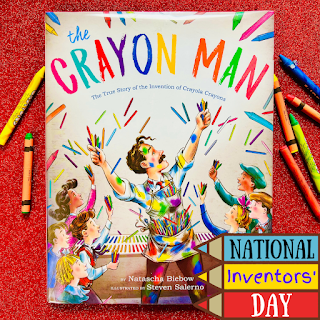
Last week on Thursday, 11 February it was National Inventors' Day.
Who knew? The reason I found out is because Eileen, an Emmy Award-winner, professional ham and YouTuber at KidTime Storytime, contacted me to ask if she could do a new read-aloud of my book THE CRAYON MAN in her signature style with . . . puppets!
When I saw her videos, I couldn't resist. They are hilarious!
Since the book's publication, National Crayon Day on 31 March has been a great hook to promote it, but this got me wondering: what other 'days' are there even out there? As an experiment, I decided to investigate what occasions fellow Picture Book Denners could use to get the word out about their latest or upcoming picture books. How can we engage with new, unexpected audiences for our writing and illustrating through this kind of lateral thinking?
Of course, in true nonfiction writer style, I soon got sucked down the rabbit hole and began imagining all kinds of new books I could write based on some of these cool themes . . .
There is no end to how creative you can be! I mean . . . 'Don't Cry Over Spilled Milk Day'? 'National Make a Friend Day . . ', 'Cow Appreciation Day', and even 'National Lollipop Day'.
Celebrations are an important part of most cultures' yearly calendars.
 We All Celebrate! by Chitra Soundar and Jenny Bloomfield
We All Celebrate! by Chitra Soundar and Jenny Bloomfield
In their book, We All Celebrate!, Jenny Bloomfield and Chitra Soundar highlight celebrations from around the world grouped by season. Filled with colour, joy and new customs and traditions for young readers to learn about and discover, it is easy to engage with each one on its featured celebration day. The all-encompassing theme inspires and encourages young readers to connect with cultural holidays around the world.
Celebrate it also on World Day for Cultural Diversity on 21 May.
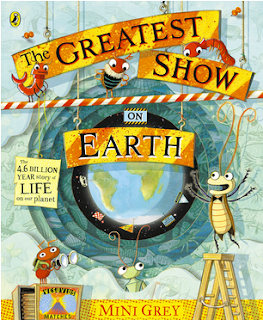 The Greatest Show on Earth by Mini Grey
The Greatest Show on Earth by Mini Grey<font size="4"><font size="3"><span style="font-family: trebuchet;">@font-face {font-family:"MS 明朝"; mso-font-charset:78; mso-generic-font-family:auto; mso-font-pitch:variable; mso-font-signature:-536870145 1791491579 18 0 131231 0;}@font-face {font-family:"Cambria Math"; panose-1:2 4 5 3 5 4 6 3 2 4; mso-font-charset:0; mso-generic-font-family:auto; mso-font-pitch:variable; mso-font-signature:-536870145 1107305727 0 0 415 0;}p.MsoNormal, li.MsoNormal, div.MsoNormal {mso-style-unhide:no; mso-style-qformat:yes; mso-style-parent:""; margin:0cm; margin-bottom:.0001pt; mso-pagination:widow-orphan; font-size:12.0pt; font-family:"Times New Roman"; mso-fareast-font-family:"MS 明朝"; mso-fareast-theme-font:minor-fareast; mso-ansi-language:EN-US;}.MsoChpDefault {mso-style-type:export-only; mso-default-props:yes; font-size:10.0pt; mso-ansi-font-size:10.0pt; mso-bidi-font-size:10.0pt; mso-fareast-font-family:"MS 明朝"; mso-fareast-theme-font:minor-fareast; mso-fareast-language:JA;}div.WordSection1 {page:WordSectio</span></font></font>
The Greatest Show on Earth by Mini Grey, which will be published in April, raises the curtain on the 4.6 million year story of Planet Earth. This sumptuous feast of a book is narrated by a friendly troop of insects who put on the show of the evolution of life on Earth – a whistle-stop tour from the birth of Earth, to the age of bacteria, the era of dinosaurs . . . to present day.
Celebrate it on Earth Day on 22 April.
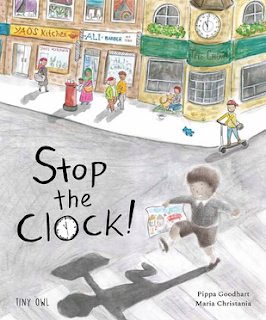 Stop the Clock! by Pippa Goodhart and Maria Christania
Stop the Clock! by Pippa Goodhart and Maria Christania
Stop the Clock! by Pippa Goodhart and Maria Christania, also published in April, tells the story of a boy who stops the clocks and goes back in time to revisit a very busy and rushed journey to school. This poignant story reminds us to slow down, take a breath and notice the small details in our busy everyday lives, and even to take time to paint them.
Celebrate it on World Sauntering Day on 19 June.
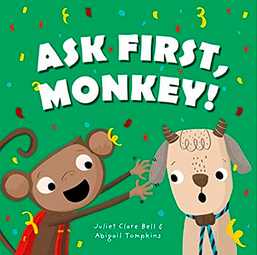 Ask First, Monkey! by Julie Clare Bell and Abigail Tompkins
Ask First, Monkey! by Julie Clare Bell and Abigail Tompkins
In Ask First, Monkey!, illustrated by Abigail Tompkins, Juliet Clare Bell tackles an important subject through story. Monkey is the best tickler in the world, ever; even his mum says so. And there's nothing he loves more than tickling ALL his friends at playtime! But what happens if some of his friends don't want to be tickled? This humorous picture book shows young children what consent is, how to consider others' feelings with respect and why it's so important. It empowers young readers to realize that a reason for 'no' is never needed - it just needs to be respected.
Celebrate it on International Day of Consent on 30 November.
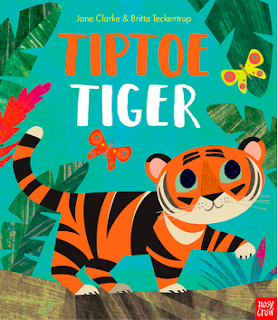 Tiptoe Tiger by Jane Clarke and Britta Teckentrup
Tiptoe Tiger by Jane Clarke and Britta TeckentrupFor every imaginative child still bouncing off the walls at the end of the day, Tiptoe Tiger by Jane Clarke and Britta Teckentrup is the perfect bedtime antidote. The interactive storytelling invites children to tiptoe round the jungle like the little tiger cub – or else scare away the beautiful butterflies and hooting owls – and to watch out for Snappy Crocodile! When at last it's bedtime, sleepy eyes will already be closing, whispering 'Night, night', just like Tiptoe Tiger.
Celebrate it on Pyjamarama Day on 13 May to promote bedtime stories for all, or even on International Tiger Day on 29 July.
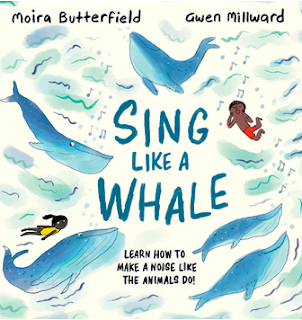 Sing Like a Whale by Moira Butterfield and Gwen Millward
Sing Like a Whale by Moira Butterfield and Gwen Millward
If you read Sing Like a Whale: Learn How to Make a Noise Like the Animals Do! by Moira Butterfield and Gwen Millward, you will learn how to hoot like an owl, howl like a wolf and sing like a whale. Wow! Readers meet 12 animals from around the world and discover the sounds they make, and why – because animals, just like people, need to get their message and feelings across.
Celebrate it on World Listening Day on 18 July.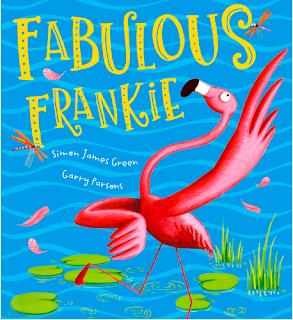 Fabulous Frankie by Simon James Green and Garry Parsons
Fabulous Frankie by Simon James Green and Garry Parsons
<font size="4"><font size="3">@font-face {font-family:"MS 明朝"; mso-font-charset:78; mso-generic-font-family:auto; mso-font-pitch:variable; mso-font-signature:-536870145 1791491579 18 0 131231 0;}@font-face {font-family:"Cambria Math"; panose-1:2 4 5 3 5 4 6 3 2 4; mso-font-charset:0; mso-generic-font-family:auto; mso-font-pitch:variable; mso-font-signature:-536870145 1107305727 0 0 415 0;}p.MsoNormal, li.MsoNormal, div.MsoNormal {mso-style-unhide:no; mso-style-qformat:yes; mso-style-parent:""; margin:0cm; margin-bottom:.0001pt; mso-pagination:widow-orphan; font-size:12.0pt; font-family:"Times New Roman"; mso-fareast-font-family:"MS 明朝"; mso-fareast-theme-font:minor-fareast; mso-ansi-language:EN-US;}p {mso-style-noshow:yes; mso-style-priority:99; mso-margin-top-alt:auto; margin-right:0cm; mso-margin-bottom-alt:auto; margin-left:0cm; mso-pagination:widow-orphan; font-size:10.0pt; font-family:"Times New Roman"; mso-fareast-font-family:"MS 明朝"; mso-fareast-theme-font:minor-fareast;}span.a-text-bold {mso-style-name:a-text-bold; mso-style-unhide:no;}.MsoChpDefault {mso-style-type:export-only; mso-default-props:yes; font-size:10.0pt; mso-ansi-font-size:10.0pt; mso-bidi-font-size:10.0pt; mso-fareast-font-family:"MS 明朝"; mso-fareast-theme-font:minor-fareast; mso-fareast-language:JA;}div.WordSection1 {page:WordSection1;}</font></font>
The hero in Fabulous Frankie by Simon James Green and Garry Parsons is a flamingo who just wants to be fabulous. But how? He's literally surrounded by so many fabulous flamingos, how on earth can he stand out from the crowd? Frankie's friends help him to discover the most important thing of all: the best way to be fabulous is to be YOU!
Celebrate it on International Being You Day on 22 May.
And today?
Today 14 February, is International Book Giving Day!
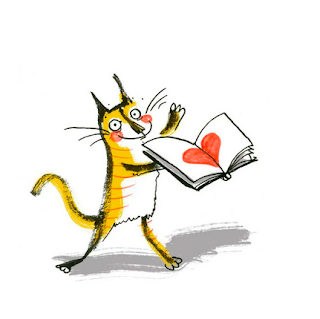 Artwork for International Book Giving Day by Viviane Schwarz
Artwork for International Book Giving Day by Viviane Schwarz
Will you be a book fairy or book ninja and leave a trail of enticing books around your neighbourhood for kids to pick up and discover? Along the school run, the dentist's waiting room, on the swings, on the walk to the library . . . You can tuck your bookmarks and bookplates inside. Join in the fun!
________________________________________________________
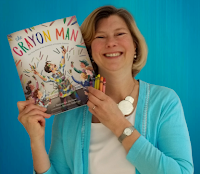 Natascha Biebow, MBE, Author, Editor and Mentor
Natascha Biebow, MBE, Author, Editor and Mentor Natascha is the author of the award-winning The Crayon Man: The True Story of the Invention of Crayola Crayons, illustrated by Steven Salerno, winner of the Irma Black Award for Excellence in Children's Books, and selected as a best STEM Book 2020. Editor of numerous prize-winning books, she runs Blue Elephant Storyshaping, an editing, coaching and mentoring service aimed at empowering writers and illustrators to fine-tune their work pre-submission, and is the Editorial Director for Five Quills. She is Co-Regional Advisor (Co-Chair) of SCBWI British Isles. Find her at www.nataschabiebow.com
<font size="4"><font size="3">@font-face {font-family:"MS 明朝"; mso-font-charset:78; mso-generic-font-family:auto; mso-font-pitch:variable; mso-font-signature:-536870145 1791491579 18 0 131231 0;}@font-face {font-family:"Cambria Math"; panose-1:2 4 5 3 5 4 6 3 2 4; mso-font-charset:0; mso-generic-font-family:auto; mso-font-pitch:variable; mso-font-signature:-536870145 1107305727 0 0 415 0;}p.MsoNormal, li.MsoNormal, div.MsoNormal {mso-style-unhide:no; mso-style-qformat:yes; mso-style-parent:""; margin:0cm; margin-bottom:.0001pt; mso-pagination:widow-orphan; font-size:12.0pt; font-family:"Times New Roman"; mso-fareast-font-family:"MS 明朝"; mso-fareast-theme-font:minor-fareast; mso-ansi-language:EN-US;}.MsoChpDefault {mso-style-type:export-only; mso-default-props:yes; font-size:10.0pt; mso-ansi-font-size:10.0pt; mso-bidi-font-size:10.0pt; mso-fareast-font-family:"MS 明朝"; mso-fareast-theme-font:minor-fareast; mso-fareast-language:JA;}div.WordSection1 {page:WordSection1;}</font></font>
<font size="4"><font size="3">@font-face {font-family:"MS 明朝"; mso-font-charset:78; mso-generic-font-family:auto; mso-font-pitch:variable; mso-font-signature:-536870145 1791491579 18 0 131231 0;}@font-face {font-family:"Cambria Math"; panose-1:2 4 5 3 5 4 6 3 2 4; mso-font-charset:0; mso-generic-font-family:auto; mso-font-pitch:variable; mso-font-signature:-536870145 1107305727 0 0 415 0;}p.MsoNormal, li.MsoNormal, div.MsoNormal {mso-style-unhide:no; mso-style-qformat:yes; mso-style-parent:""; margin:0cm; margin-bottom:.0001pt; mso-pagination:widow-orphan; font-size:12.0pt; font-family:"Times New Roman"; mso-fareast-font-family:"MS 明朝"; mso-fareast-theme-font:minor-fareast; mso-ansi-language:EN-US;}p {mso-style-noshow:yes; mso-style-priority:99; mso-margin-top-alt:auto; margin-right:0cm; mso-margin-bottom-alt:auto; margin-left:0cm; mso-pagination:widow-orphan; font-size:10.0pt; font-family:"Times New Roman"; mso-fareast-font-family:"MS 明朝"; mso-fareast-theme-font:minor-fareast;}span.a-text-bold {mso-style-name:a-text-bold; mso-style-unhide:no;}.MsoChpDefault {mso-style-type:export-only; mso-default-props:yes; font-size:10.0pt; mso-ansi-font-size:10.0pt; mso-bidi-font-size:10.0pt; mso-fareast-font-family:"MS 明朝"; mso-fareast-theme-font:minor-fareast; mso-fareast-language:JA;}div.WordSection1 {page:WordSection1;}</font></font>
<font size="4"><font size="3">@font-face {font-family:"MS 明朝"; mso-font-charset:78; mso-generic-font-family:auto; mso-font-pitch:variable; mso-font-signature:-536870145 1791491579 18 0 131231 0;}@font-face {font-family:"MS 明朝"; mso-font-charset:78; mso-generic-font-family:auto; mso-font-pitch:variable; mso-font-signature:-536870145 1791491579 18 0 131231 0;}p.MsoNormal, li.MsoNormal, div.MsoNormal {mso-style-unhide:no; mso-style-qformat:yes; mso-style-parent:""; margin:0cm; margin-bottom:.0001pt; mso-pagination:widow-orphan; font-size:12.0pt; font-family:"Times New Roman"; mso-fareast-font-family:"MS 明朝"; mso-fareast-theme-font:minor-fareast; mso-ansi-language:EN-US;}.MsoChpDefault {mso-style-type:export-only; mso-default-props:yes; font-size:10.0pt; mso-ansi-font-size:10.0pt; mso-bidi-font-size:10.0pt; mso-fareast-font-family:"MS 明朝"; mso-fareast-theme-font:minor-fareast; mso-fareast-language:JA;}div.WordSection1 {page:WordSection1;}</font></font>

